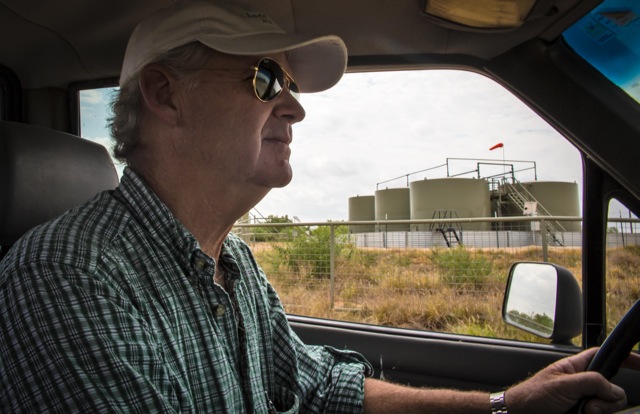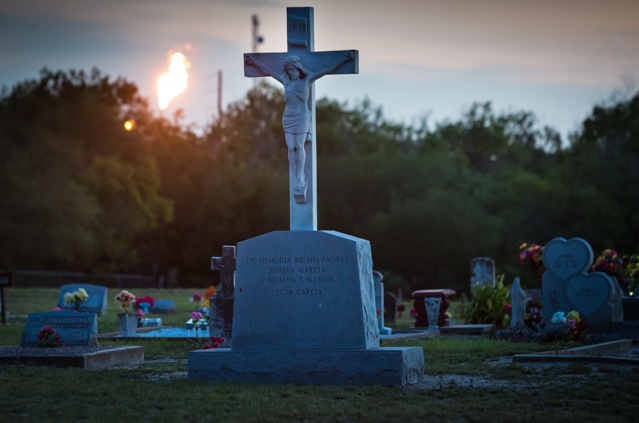Hugh Fitzsimons lll, a buffalo rancher on the outskirts of Carrizo Springs, Texas, cautiously watches the fracking industry’s accelerating expansion. His 13,000-acre ranch is atop the southwestern part of the oil-rich Eagle Ford Shale, which stretches from Leon County in northeast Texas to Laredo, along the Mexican border.
During the last two years Fitzsimons has watched the fracking boom transform a rural locale into an industry hub. Desolate dirt roads are now packed with truck traffic, and commercial development to service the growing industry has sprung up along state highways, creating air and noise pollution.

Hugh A. Fitzsimons lll on a dirt road near his ranch in the Eagle Ford Shale. ©2014 Julie Dermansky for Oceans 8 Films
Though Fitzsimons stands to profit from oil extraction, he has not turned a blind eye to the industry’s damaging effects on the environment. He wants to make sure the expanding industry acts responsibly and is doing his part to ensure that happens, a tall order since a state-sponsored report estimates the number of wells could grow from 8,000 to 32,000 by 2018 and industry polices itself for the most part.

Hugh A. Fitzsimons lll’s buffalo next to a pumpjack on his ranch. ©2014 Julie Dermansky for Oceans 8 Films
The two Texas regulatory agencies that handle concerns and complaints about the fracking industry are the Texas Railroad Commission and the Texas Commission on Environmental Quality (TCEQ). According to a report on the Eagle Ford Shale’s air quality by the center for Public Integrity, Inside Climate News and the Weather Channel, “Texas regulatory agencies reveal a system that does more to protect the industry than the public”.
One of the key findings in the report: “Texas’ air monitoring system is so flawed that the state knows almost nothing about the extent of the pollution in the Eagle Ford. Only five permanent air monitors are installed in the 20,000-square-mile region, and all are at the fringes of the shale play, far from the heavy drilling areas where emissions are highest.“
Furthermore, despite hundreds of complaints about polluted air in the last two fiscal years, the TCEQ has levied only 35 fines, according to the New York Times.
And the Texas Railroad Commission has not been satisfied with scientists’ proof that the fracking industry has contaminated water in the state, despite mounting evidence.
Flare from a fracking industry site in Karnes County, Texas. ©2014 Julie Dermansky for Oceans 8 Films
Fitzsimons served on the Wintergreen Water Conservation District for Dimmit County. He wants to get the fracking industry to utilize brackish water for frack jobs that each require millions of gallons of water, instead of permitting water from the aquifer or the Rio Grande River to be used.
“The Rio Grande River is one of the most endangered rivers in the world,” he told DeSmogBlog, adding that the amount of water being drawn form the aquifer jeopardizes the region’s drinking water already threatened by drought.
Recently his ranch foreman learned to operate a FLIR camera, a tool used by regulators that documents fumes not visible to the naked eye. With eight wells being drilled on his ranch in the coming months, he will supplement any monitoring the state can offer.
Frack job in Karnes County, Texas. ©2014 Julie Dermansky for Oceans 8 Films
It is a good idea, considering the experiences of residents of Karnes County, at the epicenter of the Eagle Ford Shale’s fracking boom. Some who have made air quality complaints to the TQEQ told DeSmogBlog it takes days before a regulator shows up and by then, the problem often has subsided. Emissions are also at their worst at night, but regulators normally only monitor the air during the day.
Lynn D. Buehring, one of those residents, has called the TCEQ 125 time this year alone. There have been more then 50 wells drilled within 2.5 miles of her home. This summer, there was a drilling rig a couple of hundred feet behind her house and two flares burning at other sites visible from her front porch.
Lynn D. Buehring often wears a respirator outside of her home in Karnes County. ©2014 Julie Dermansky for Oceans 8 Films
Flare at a fracking industry site near Lynn Buehring’s home in Karnes County. ©2014 Julie Dermansky for Oceans 8 Films
Buehring filed a lawsuit against Marathon Oil Corp, claiming the company’s operations have diminished her quality of life and negatively impacted her health. She developed breathing problems shortly after the fracking began and suffers from ailments often associated with exposure to toxic air including nose bleeds, heads aches and dizziness. The air is so bad some days, she doesn’t go outside at all.
Buehring’s case is on hold, pending the outcome of a case filed by the Cerny family, Karnes County residents represented by Buehring’s lawyer Thomas Ramirez lll. A state district judge threw out the Cerny’s case in August. The judgment is now being appealed the Texas Court of Appeals.
Ramirez vehemently disagrees with the judge’s decision not to hear these cases. Besides believing the law is on his side, “People’s lives are in the balance,” he told DeSmogBlog. “It could take anywhere from nine months to two years before the Cerny’s case is considered.”
One positive thing about the delay is mounting scientific evidence that backs the clients’ claims.
Fighting against oil companies in Texas makes you an automatic underdog. The risk of experiencing a backlash if you speak up against fracking is daunting since most have family members who work in the industry. In Denton, Texas, those who fought and won a ban against fracking were met with McCarthy-era tactics; two Texas commissioners insinuated that those supporting the ban were funded by Russia.
Some choose to leave instead of fight. The Grassland Oasis Farm near Floresville, formerly run by Fred and Amber Lyssy, closed in November. Six of their dogs died after fracking sites started operating next to the farm. Their concerns about the health of the livestock and family weighed on them. They considered fighting the industry, but chose to leave. Fred Lyssy will now be managing a farm in Virginia.
Fred and Amber Lyssy with their children at the Grassland Oasis, now closed. ©2014 Julie Dermansky for Oceans 8 Films
Grassfed livestock at the Grassland Oasis in June, now closed. ©2014 Julie Dermansky for Oceans 8 Films
Just how long will the boom last and what will be left in its wake?
Fitzsimons questions the size of the supply of oil after he noticed pumpjacks being utilized in a shorter period of time after a frack job was completed than before.
“This is a sign the newer wells might not be as productive as the earlier wells,” he says. Pumpjacks are used to help keep the oil flowing after a frack job, when the flow slows down.
His observations match a prediction made by J. David Hughes, a geoscientist with Post Carbon Institute in his 2012 report for the institute. He wrote that the fracking industry would create a “drilling treadmill.” Operators will need to drill more wells to keep production levels at the status quo because the “sweet spots” were drilled first, maximizing production, leaving areas with less rich oil and gas bounties to be found and drilled.
“Drilling Deeper,” a follow-up report Hughes coauthored for the Post Carbon Institute this year, predicts that Eagle Ford Shale’s production will peak some time this decade and then drop to a fraction of today’s totals by 2040, far below the U.S. Energy Information Administration projections.
Fracking industry site in Karnes County, the epicenter of the Eagle Ford Shale. ©2014 Julie Dermansky for Oceans 8 Films
Falling gas prices have threatened to curtail the fracking boom sooner than expected. Operators in the Bakken Shale Region and the Permian Basin are in the red, according to a Business Insider report.
Though Eagle Ford Shale operators are still turning a profit, industry workers in Karnes County are beginning to worry about their jobs. Buehring’s husband told her that potential layoffs are the conversation of the day at truck-stop cafes where he and other locals congregate with industry workers.
Even if the boom comes to an end earlier than predicted, Fitzsimons worries the water will run out before the party is over.
“The regulatory agencies have not kept up with technology. They need to revamp what they are doing,” Fitzsimons says. “We have 1930 rules regulating 21st century oil fields.”
“In Texas the oil and gas industry is king,” Ramirez says, but he is not one to walk away from what he sees as a righteous fight. As the boom continues, he thinks the tide will turn as more people experience health problems associated with the cumulative effects of breathing toxic emissions produced by the fracking industry. Although he, like Fitzsimons, hopes industry will correct its ways and operate more responsibly, he isn’t holding his breath while he battles on.
Subscribe to our newsletter
Stay up to date with DeSmog news and alerts













